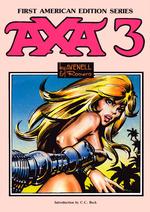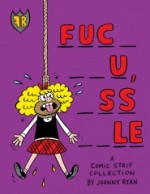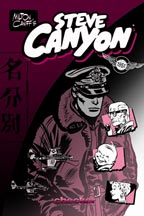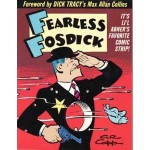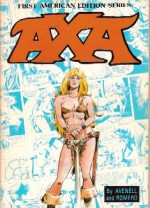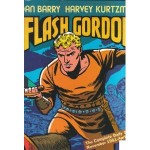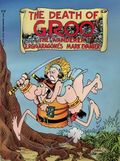
By Roy Crane (Fantagraphics Books)
ISBN: 978-1-60699-362-0
Modern comics evolved from newspaper comic strips, and these pictorial features were until relatively recently utterly ubiquitous and hugely popular with the public – and highly valued by publishers who used them as an irresistible sales weapon to guarantee and increase circulation and profits.
It’s virtually impossible for us to today to understand the overwhelming power of the comic strip in America (and the wider world) from the Great Depression to the end of World War II. With no television, broadcast radio far from universal and movie shows at best a weekly treat for most folk, household entertainment was mostly derived from the comic sections of daily and especially Sunday Newspapers. “The Funnies†were the most common recreation for millions who were well served by a fantastic variety and incredible quality.
From the very start humour was paramount; hence the terms “Funnies†and “Comicsâ€, and from these gag and stunt beginnings – a blend of silent movie slapstick, outrageous fantasy and the vaudeville shows – came a thoroughly entertaining mutant hybrid: Roy Crane’s Wash Tubbs.
Debuting on April 21st 1924 Washington Tubbs II was a comedic gag-a-day strip that evolved into a globe-girdling adventure serial. Crane produced pages of stunning, addictive quality yarn-spinning whilst his introduction of moody swashbuckler Captain Easy in the landmark episode for 6th May, 1929 led to a Sunday colour page that was possibly the most compelling and visually impressive of the entire Golden Age of Newspaper strips (see Roy Crane’s Captain Easy, Soldier of Fortune: The Complete Sunday Newspaper Strips volume 1)
Almost improving minute by minute Crane’s imagination and his fabulous visual masterpieces achieved a timeless immediacy that made each page a unified piece of sequential art. The influence of those pages can be seen in the works of near-contemporaries such as Hergé, giants-in-waiting like Charles Schulz and comics creators like Alex Toth and John Severin ever since.
The work was obviously as much fun to create as to read. In fact, the cited reason for Crane surrendering the Sunday strip to his assistant Les turner in 1937 was the NEA/United Features Syndicate’s abrupt and arbitrary demand that all its strips must henceforward be produced in a rigid panel-structure to facilitate their being cut up and re-pasted as local editors dictated – although the compelling text features in this book dedicated to his second masterpiece reveal a few more commercial and professional reasons for the jump from the small and provincial syndicate to the monolithic King Features outfit.
At the height of his powers Crane just walked away from the astounding Captain Easy page, concentrating on the daily feature, and when his contract expired in 1943 he left United Features to create the World War II aviation strip Buz Sawyer, lured away by the grandee of strip poachers William Randolph Hearst.
Where Wash Tubbs was a brave but comedic Lothario and Easy a surly tight-lipped he-man, John Singer “Buz†Sawyer was a happy amalgam of the two: a simple good-looking popular country-boy who went to war because his country needed him.
After the gripping and informative text feature ‘Crane’s Great Gamble’ by Jeet Heer the strip explodes into action on Christmas Eve 1942 as new Essex Class Aircraft Carrier USS Tippecanoe steams for the Pacific Theatre of Operation carrying 100 fighter-bombers and an extremely keen pair of cartoon warriors.
Buz Sawyer was a fun-loving, skirt-chasing, musically inclined pilot and his devoted gunner Rosco Sweeney a bluff, simple ordinary Joe – and one of the best comedy foils ever created. The strip is a marvel of authenticity: picturing not just the action and drama of the locale and situation but more importantly capturing the quiet, dull hours of training, routine and desperate larks between the serious business of killing whilst staying alive.
Like contemporaries Bill Mauldin and Milton Caniff, Crane was acutely aware that all his readers had someone involved in the action and therefore felt he had a duty to inform and enlighten as well as entertain. Spectacular as the adventure was the true magic is the off-duty camaraderie and personal moments that pepper the daily drama.
This beautiful archival hardback covers the entire war years of the strip from November 1st 1943 to October 5th 1945 wherein the great artist perfected his masterly skill with craftint (a mechanical monochrome patterning effect used to add greys and halftones which Crane used to add miraculous depths and moods to his superb drawing) and opens with the lovable lads shot down whilst tackling a Japanese carrier.
Marooned, their life raft washed up on a desolate desert island where they’re hunted by enemy troops and discover a German farmer and his beautiful daughter. At first hostile, the lovely fraulein, April, soon succumbs to Buz’s boyish charm. Helping Buz and Roscoe escape, the trio only make it as far as the next islet where fellow pilot and friendly rival Chili Harrison had also been stranded since his plane went down.
Eventually rescued the Navy fliers return to “the Tip†for training on new planes (Curtiss SB2C Helldivers, in case you were wondering) in preparation for the push to Japan. Amidst spectacular action sequences shipboard life goes on, but during a raid on an occupied island Buz and Sweeney are once more shot down. In the middle of a fire-fight they effect repairs and head back to the Tippecanoe, but not without cost. Rosco has been hit…
Sawyer’s exploits haven’t gone unnoticed and, whilst Sweeney is recovering from wounds, he’s selected for a secret mission deep into enemy territory; ferrying an intelligence agent to a meeting with enigmatic underground leader the Cobra.
It all goes tragically wrong and the American agent is captured. With the enemy hunting high and low for the pilot, Buz then fell back on his most infuriating ability: falling into the willing laps of beautiful women.
‘Sultry’ was a gorgeous collaborator high in the favour of the occupying Japanese, but she too finds the corn-fed aviator irresistible. Of course it might simply be that she’s also Cobra…
This extended epic is a brilliant and breathtaking adventure that blends action, suspense, love and tragedy into a compelling thriller that took Buz all the way to December 1944. As a result of his trials the hero is sent home on a thirty day leave – enabling Crane to reveal some enticing background and invoke all the passions, joys and heartbreaks of the Home Front.
Buz doesn’t want to go but orders are order, so to make things a little more bearable Buz takes the still recuperating Sweeney with him. It isn’t that the young flier despises his origins – indeed his civilian life is a purely idyllic American Dream – it’s simply that he wanted to get the job done against the enemy. Nevertheless, with a warrior’s grace under pressure, he resigned himself to peace and enjoyment whilst his comrades soldier on. If he knew the foe he would face in his little hometown, Buz would probably have gone AWOL…
Crane’s inspirational use of the War at Home was a brilliant stroke: it’s not a world of spies and insidious Bundists but just a sweet little burg filled with home-comforts and proud people – the kind of place the soldiers were fighting to preserve and a powerful tool in the morale-builder’s arsenal. It’s also a place of completely different dangers…
Buz was the son of the town’s doctor; plain, simple and good-hearted. In that egalitarian environment the kid was the sweetheart of Tot Winter, the richest girl in town, and when her upstart nouveau riche parents heard of the decorated hero’s return they hijacked the homecoming and turned it into a publicity carnival.
Moreover the ghastly, snobbish Mrs. Winter conspired with her daughter to trap the lad into a quick and newsworthy marriage. Class, prejudice, financial greed and social climbing were enemies Buz and Sweeney were ill-equipped to fight, but luckily that annoying tomboy-brat Christy Jameson has blossomed into a sensible, down-to-earth, practical and clever young woman. She’s scrubbed up real pretty too…
After a staggeringly smart and compelling soap opera sequence that would do East Enders or Coronation Street proud, Buz ended up (accidentally) engaged to Tot after all. Mercifully the leave was over and he and Sweeney had to return to the war… but even then they were disappointed to discover that they wouldn’t immediately be fighting again.
Posted to Monterey, California, they were to be retrained for new planes and a new squadron, reuniting with rowdy rival Chili Harrison: but Mrs Winter was determined to have a war hero in the clan and pursued them with Tot in tow, determined to get Buz married before he returned to the Pacific.
Insights into another aspect of the military experience (Crane had almost unfettered access, consultation privileges and the grateful willing cooperation of the US Navy) were revealed to the readers as the whiz-kid was suddenly back in school again – and usually in the dog-house because of his hot-dogging. Dramatic tension was evenly split between Buz’s apparent inability to be a team-player and the increasingly insistent ploys of Mrs. Winter.
Moreover, the squadron’s training commander had an uncanny ability to predict which pilots would die in training or combat and Buz’s name was high on that list…
At last the training was over and, miraculously alive and unmarried, Buz and Sweeney shipped back to the Pacific and the relatively easy task of ending the war. Part of a massive fleet mopping up the island fortresses en route to Tokyo they were soon flying combat missions and before long, shot down once more. This time they were taken prisoner aboard an enemy submarine…
After another incredible escape and rousing triumph the war ended, but Crane actually ratcheted up the tension by covering the period of American consolidation and occupation as Buz and Sweeney awaited demobilisation. Whilst posted to a medical facility in Melatonga the boys and Chili came across a woman from Buz’s chequered past they had all believed long dead…
When their discharge papers finally arrived (in the episode for September 9th 1945) an era of desperate struggle was over. However with such a popular and pivotal strip as Buz Sawyer that only meant that the Era of Globe-Girdling adventure was about to begin…
This superb black and white hardback also contains a selection of Sunday strips in full colour. The eternal dichotomy and difficulty of producing Sunday Pages (many client papers would only buy dailies or Sunday strips, not both) meant that many strip creators would produce different story-lines for each feature – Milt Caniff’s Steve Canyon being one of the few notable exceptions.
Crane handled the problem with typical aplomb: using the Sundays to tell completely unrelated stories. For Wash Tubbs he created a prequel series starring Captain Easy in adventures set before the mismatched pair had met; in Buz Sawyer he turned over the Sabbath slot to Rosco Sweeney for lavish gag-a-day exploits, big on laughs and situation comedy. Set among the common “swabbies†aboard ship it was a far more family-oriented feature and probably much more welcome among the weekend crowd of parents and children than the often chilling or disturbing realistically and sophisticated saga that unfolded Mondays to Saturdays.
Also included here in delicious full-page fold outs are fifteen of the best – many with appearances by Buz (spanning November 28th 1943 to 25th February 1945) – a cheerily tantalising bonus which will hopefully turn one day into a archival collection of their own. Whilst not as innovative or groundbreaking as Captain Easy, they’re still proficient works by one of the Grand masters of our art-form.
This initial collection is the perfect means of discovering or rediscovering Crane’s second magnum opus – spectacular, enthralling, exotically immediate adventures that influenced generations of modern cartoonists, illustrators, comics creators and storytellers. Buz Sawyer: War in the Pacific ranks as one the greatest strip sequences ever created: stirring, thrilling, funny and moving tale-spinning that is unforgettable, unmissable and utterly irresistible.
Strips © 2010 King Features Syndicate, Inc. This edition © 2011 Fantagraphics Books, all other material © the respective copyright holders. All rights reserved.


